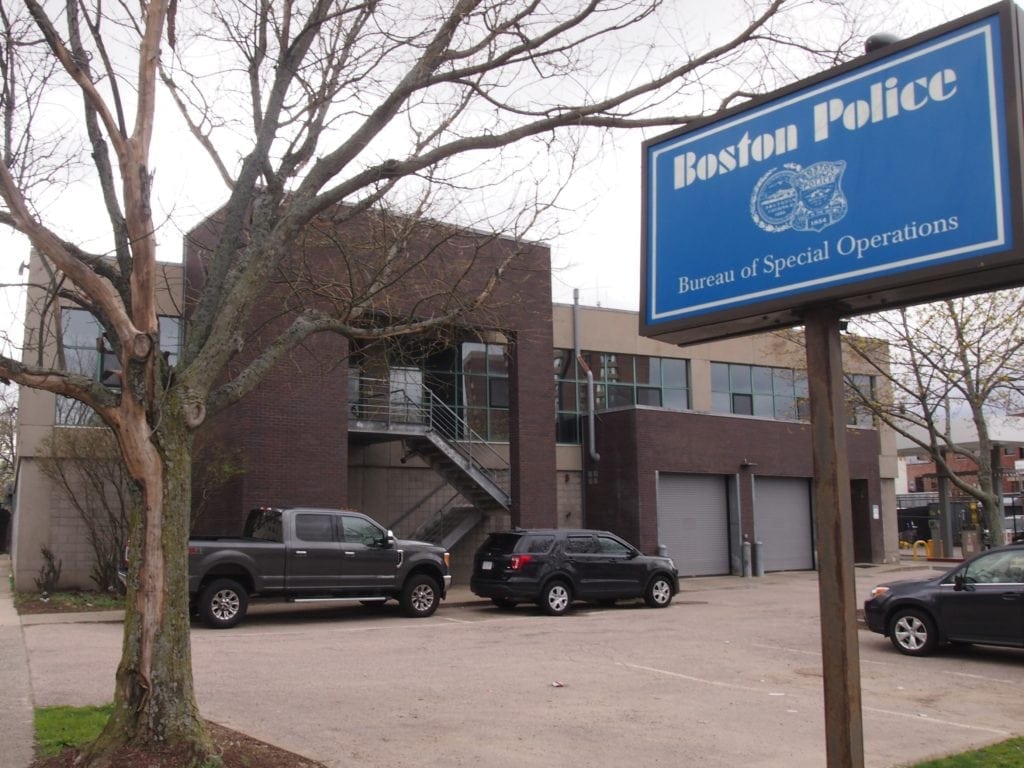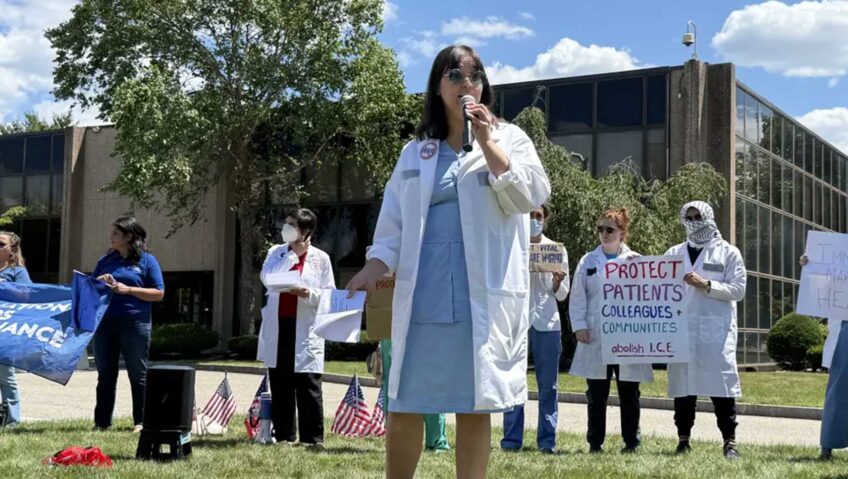Advocates say innocent teens are stamped with ‘gang’ label
Boston's gang database operates with little oversight, zero transparency

Every year, thousands of teens in Boston’s neighborhoods are stopped, questioned, searched and targeted for prosecution by police officers.
For those who are identified as gang members or “gang associated,” criminal justice reform advocates say, this kind of scrutiny is magnified, including daily stops and searches and leading to harsher sentences for criminal convictions and in some cases, deportation by federal immigration officials.
The Boston Police Department maintains a gang database in which they enter names and information on individuals they believe to be gang members or associated with gang members. But with no oversight from agencies or individuals outside the police department, critics say the database could be unfairly targeting black and Latino youth, sharing inaccurate information with federal authorities and even putting teens in harm’s way.
“If you’re a Salvadoran kid in a predominantly Latino high school and you’re sitting at a lunch table with a kid who’s in a gang, that shouldn’t be an indicator that you’re involved in a gang,” said attorney Sarah Sherman-Stokes, associate director of the Immigrants’ Rights and Human Trafficking Clinic at Boston University School of Law.
The BPD’s gang database is controversial because there’s little transparency about who is in it, what groups the department considers to be gangs and with whom police are sharing the database information.
In an interview with the Banner Monday, police officials would not share information about how many gangs and how many individuals are in the database. When pressed, police spokesman Sergeant John Boyle would not even say whether the number of individuals logged in the database is in the hundreds or thousands.
“We don’t give that information out for investigative reasons,” he said repeatedly in response to Banner reporters’ requests for specific information about the database. Boyle said the department would not share internal data from the BPD list with the Banner.
In April, the investigative news website ProPublica released a series of articles documenting numerous inaccuracies in a gang database maintained by the Chicago Police Department.
Innocent bystanders
Defense attorneys and criminal justice reform advocates say teens whom police misidentify as gang members can face dire consequences, especially those with a pending immigration status.
Sherman-Stokes’ client, a student at East Boston High School, was taken into custody last year by federal immigration officials after he was identified in an incident report following a confrontation in a school cafeteria. The student, she said, was labeled as a “gang associate,” a designation that would put him in the BPD gang database, despite his having no affiliation with a gang.
That incident report was then relayed to the Boston Regional Intelligence Center, a data analysis unit at the BPD that shares information with federal law enforcement agencies such as U.S. Immigration and Customs Enforcement and the U.S. Department of Homeland Security.
BRIC manages and oversees the BPD gang database, according to information acquired through a public records request in 2017 by Kade Crockford, director of the Technology for Liberty Program at the American Civil Liberties Union of Massachusetts.
Crockford said the department’s use of the database presents challenges for defendants facing immigration charges.
“One of the things immigration attorneys are trying to argue in court is that because of the criteria and how they are added to the database, it allows for the use of innuendo — stuff that has nothing to do with crime or violence at all,” she said. “It shouldn’t be allowed to serve as a justification for deporting someone.”
Federal agencies, such as ICE, do not have direct access to the gang database. But through software called COPLINK, ICE agents are given instant access to police incident reports, wherein officers often identify individuals as gang members or gang associates.
Point system
Boston police officers working with the department’s Youth Violence Strike Force, commonly referred to as the gang unit, use a ten-point scoring system to qualify teens as gang members.
The point system was adopted from the Massachusetts Department of Correction, according to Boyle.
Points are awarded for criteria such as self-identification, gang tattoos and information from informants or rival gang members. People are determined to be gang members if their criteria add up to 10 points, and labeled a gang associate if their criteria reach at least six points.
Some criteria are more heavily weighted than others. For example, “prior validation by a law enforcement agency” is worth nine points and “known group tattoo or marking” is worth eight points.
But points are also awarded for things as vague as “contact with known gang member/associate.” Subjects are awarded two points for each such interaction.
Other items in the 10-point verification system include “victim/target affiliated with member of rival group,” which garners eight points if not in custody or incarcerated and three points if in custody or incarcerated; “information from reliable, confidential informant,” worth five points, and “use or possession of group paraphernalia or identifiers,” worth four points.
“What’s troubling about a lot of this stuff is, even if a young person is involved, that doesn’t mean that they always will be,” said Crockford. “The use of this database, I think, perversely makes it very difficult for young people to get out of that type of lifestyle. Once they’ve been identified this way by the BPD, there is this sort of … the more you say something to someone, the more it becomes true.”
Because the database relies on law enforcement officers, school officials and confidential informants to make determinations of who is gang-involved, the determinations are often unreliable, says Fatema Ahmad, deputy director of the Muslim Justice League, a group that organizes around civil and human rights abuses under national security pretexts.
“The scoring system is absurd,” she said. “They call it a ‘10-point system,’ but it only takes six points to be labeled a gang associate. They could look you up on Facebook and see an item of clothing they think is associated with a gang.”
Five instances of contact with people police consider gang members could earn a subject designation as a gang member. In neighborhoods such as East Boston, where there is well-documented gang activity, it’s nearly impossible for teenagers to steer clear of people police consider gang members.
In Rule 335, which established the Youth Violence Strike Force, the BPD defines a gang as three or more people organized formally or informally who meet criteria including use of a common name, identifying signs, colors or symbols, or who frequent a specific area. The group must have members or associates who “individually or collectively, engage in or have engaged in criminal activity which may include incidents of targeting rival gang members and/or being targeted by other gangs.”
Sherman-Stokes noted that this definition can cast an overly wide net.
“Kids can get logged into the database for loitering in Bremen Park, “she said. “That’s not criminal activity. It’s called being a teenager.”
‘How did I get here?’
Alex Ponte-Capellan has no idea how he was logged into the gang database. He was not a gang member in 2009 when a police officer stationed in Downtown Crossing pulled him aside, told him he was in the database and showed him a file with his name, photograph and personal information.
“He said, ‘We’re keeping an eye on you,’” said Ponte-Capellan, who now works as an organizer with the anti-displacement group City Life/Vida Urbana. “I was kind of terrified, but I didn’t know exactly what it meant.”
Ponte-Capellan, a U.S. citizen who was then living in Roxbury, soon found out. Plainclothes officers in unmarked cars began aggressively pursuing him. He was in the crosshairs of the BPD’s gang unit, an outfit with what critics say is a well-deserved reputation for abusive behavior.
“It was a different kind of cop,” he said. “It was gang unit detectives who were super-invasive. They came to my house and talked to my parents. They’d be waiting for me in front of my house. They were kind of harassing me everywhere I went.”
Although Ponte-Capellan denied being a gang member, there is no formal procedure for subjects labeled gang members or gang-associated to have themselves removed from the database. After five years without arrests or documented association with other gang members, however, subjects in the database are labeled “inactive.” After 10 years, they are removed from the system.
In Boston, 50 percent of the people in the database are considered inactive, Boyle said.
ProPublica’s Chicago investigation revealed that the city’s police department had more than 128,000 people in its gang database, with 70 percent of them being black and 25 percent Hispanic.
Crockford said that although they have not yet been able to obtain the exact numbers from the BPD, she suspects there are similar racial disparities in Boston’s gang database.






